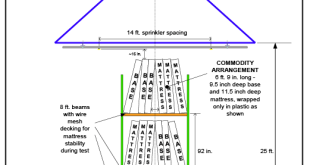
DESIGN SCHOOLS UPDATED
Added Instruction Aids With NICET’S New WBSL Exams
The American Fire Sprinkler Association (AFSA) is proud to announce that its Beginning and Intermediate Design Schools have been updated to NICET’s new exams for Water-Based Systems Layout (WBSL) certifications.
NICET’s Water-Based Systems Layout certification program is for engineering technicians engaged in the layout and detailing of water-based systems that must meet code and statutory requirements. Its exams have been updated as of July 8, 2024. Graduating from AFSA’s schools may help students be better prepared for the NICET WBSL exam.
“This school offers trainees a focused learning path that teaches them to understand the layout and basics of NFPA 13 so that design criteria, including water supplies and sprinkler location, can be more easily located and applied,” says AFSA Vice President of Education Services Leslie Clounts. “No one expects you to memorize NFPA 13, but knowing where to find the information quickly can make you a more proficient designer, and definitely helps when taking timed certification exams like NICET’s WBSL.”
Take advantage of this opportunity by attending the last schools being held in 2024: The next Beginning Design School will be Oct. 29 – Nov. 22 and the next Intermediate Design School will be Nov. 5-15. Both schools will be offered as a hybrid format of virtual and in-person learning.
New and improved class instruction now includes time in AFSA’s new training lab! Said one recent graduate, “The class was very engaging, I enjoyed being able to do hands-on activities in the lab; it helped me connect the knowledge from paper to real life application.”
BEGINNING DESIGN SCHOOL
The Beginning Design School presents a comprehensive, practical approach to preparing fire sprinkler system drawings. Over a three-week period, students will attend six live webinars studying and reviewing the installation and design approach requirements of NFPA 13 (2022) while completing self-paced exercises and module assessments. Q&A sessions and open discussions will also be included as part of the online instruction. The second part of the class will be a week of in-person training, preparing fire sprinkler system layout, shop drawings, and hydraulic calculations by hand. The course concludes with a comprehensive exam of the class content including the installation requirements and hydraulics. There is no CAD or third-party software taught in this class.
Student feedback on the school has been excellent. “I thought Josh was a great instructor. He was extremely engaging, understanding, and knowledgeable. I also thought Eric was very knowledgeable on each subject. While he only taught us for two days, I feel I learned a lot from him. Transportation was perfect, lunches were delicious, and the class was engaging.”
The school will prepare the student to:
- Accelerate the comprehension of plans and various types of building construction for proper sprinkler spacing applications.
- Determine the proper sprinkler system layout and installation requirements and methods.
- Interpret sprinkler specifications, plans (shop drawings), manufacturer’s technical data sheets, and flow tests.
- Identify sprinkler types, system types, pipe types, hangers, fittings, system components, etc.
- Explain the coordination with other trades—plumbing, mechanical, electrical, and structural.
- Prepare hand sprinkler drawings and hydraulic calculations and identify the hydraulic inputs to explain computer outputs.
Another student commented, “[Josh McDonald] made the learning experience a lot more enjoyable and made the process easy to learn for everyone’s learning style and pace. Everything was above expectations.”
This class is designed for trainees and entry-level technicians with at least six months experience as well as those with experience in the sprinkler trade looking to make the transition to system layout. Visit www.firesprinkler.org/programs/beginning-fire-sprinkler-
system-planning-school/to learn more and to register.
“I spent four-and-a-half years in college. This course, by an incredibly large margin, was the best course I have ever taken,” submitted one graduate from the school. “In addition, Josh was the best instructor I have ever had. He made insurmountable concepts easier to understand to someone who only has four months in the industry. I eagerly await the time I can take the next class with Josh and this organization. … The pace and overall ability of the instructors is without comparison in my experience.”
INTERMEDIATE DESIGN SCHOOL
Experienced layout technicians will find AFSA’s Intermediate Design School a blended learning course useful to understand the tools they utilize in-depth and gain a deeper knowledge of layouts for standpipe systems, fire pumps, seismic protection, and the design requirements for general storage. In addition to mastering requirements in NFPA 13, NFPA 14, and NFPA 20, students will utilize computer modeling software to apply design requirements learned throughout the course, becoming familiar with the BIM process. This course begins with an orientation and two three-hour webinars followed by five days of guided, in-person instruction. The school will prepare the student to:
- Classify commodities and storage arrangements.
- Compare installation requirements for storage sprinklers (CMDA, CMSA, and ESFR).
- Use computer modeling of a sprinkler system to illustrate and confirm installation requirements for storage sprinklers (CMDA, CMSA, and ESFR).
- Determine a standpipe system’s appropriate component, installation, and design requirements.
- Recognize the components and prepare shop drawings where seismic protection is required.
- Select an appropriate fire pump based on available supply and system demand and verify using a computer model.
Instructor evaluations show that student retainment and engagement is paramount. “Josh McDonald was very engaging and funny which made it easy to stay interested in the material. He did a good job explaining the why behind everything,” says one graduate.
“Kevin was a great instructor, very polite and above all very knowledgeable. Josh is a very good teacher, explaining things in a manner that made some of the technical parts of our jobs a lot more understandable. His analogies were a great way to paint a better picture as well,” comments another student.
This class is designed for competent trainees and technicians with at least one year of system layout experience. No prior Hydratec or Autodesk® Revit® experience is required. Students should be computer literate.
READY FOR THE NEXT LEVEL?

 Sprinkler Age A Publication of the American Fire Sprinkler Association
Sprinkler Age A Publication of the American Fire Sprinkler Association



